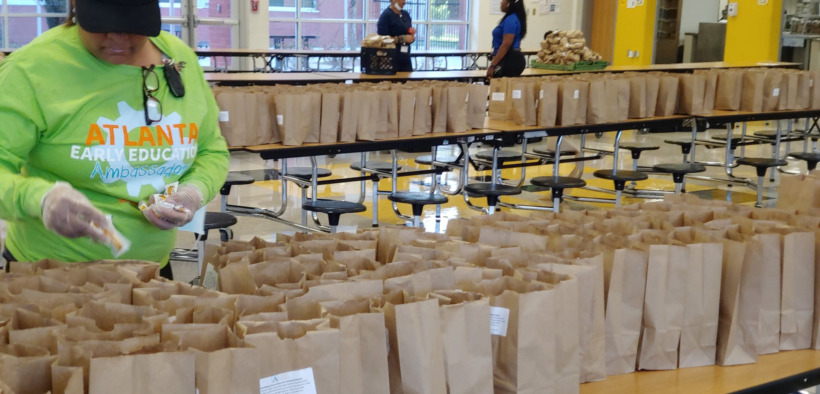Children Should Not Go Hungry When Classrooms Close

By: GEEARS and Georgia Statewide Afterschool Network (GSAN) for Saporta Report
Imagine facing the day with a grumbling belly and an empty refrigerator. And imagine if you’re a young child, missing your teachers and friends while struggling to focus on a computer screen. That is the situation facing many children in Atlanta right now, as bureaucratic barriers have made the delivery of food assistance a challenge.
Unfortunately, many parents in Atlanta are wondering how they will put food on the table. COVID-19 has disrupted the food systems in metro Atlanta, and that includes the school nutrition programs that many families rely on astheir districts moved to virtual learning. The community has stepped in, with early care and learning facilities, summer camps, and afterschool programs finding ways to feed the children in their communities. New federal assistance has also helped to fill the gaps in family budgets.
As the new school year begins, we must ensure these programs can be innovative, strong, and flexible enough to meet the ongoing child hunger crisis. Political squabbles and bureaucratic hurdles must not get in the way of helping our children eat.
Before the COVID-19 pandemic, 17.5% of Georgia’s children lived in a food insecure household, with more than 400,000 children struggling with hunger. Schools provided an invaluable lifeline to these families, with Georgia’s Department of Education School Nutrition Program (GaDOESN) reporting having provided an esitmated 1,174,602 students with lunches daily during the 2018-2019 school year through the U.S. Department of Agriculture’s free and reduced-price lunch program.
The school closures that began in March have meant that children miss not only their classrooms, teachers, and classmates, but also a key source of nutrition. Feeding America estimates the COVID-19 pandemic could mean 6.8 million more children across the U.S. will face hunger. A variety of governmental and philanthropic programs have stepped in to provide a continuum of care. GaDOESN reports it has provided 35 million meals during school closures.
In focus groups recently conducted by GEEARS, many parents of young children cited food and nutrition supports as valuable resources during the pandemic.
“The USDA program provided lunches and breakfast bags for the kids from March until now,” one parent told us. “That was a really good resource for us. All my kids do is eat. The extra snacks and stuff helped because I’m a single parent.”
“Our county has started giving out food to families,” another parent said. “You have to go get it, but the free lunch was helpful for a lot of families.”
The federal government has also made additional assistance available through the Pandemic Electronic Benefit Transfer (P-EBT), created through the Families First Coronavirus Response Act. P-EBT provides a one-time $256.50 per-child payment to families of public school children who received free and reduced-price lunch during the 2019-2020 school year. Families have until September 25 to apply online and can call the Georgia Division of Family and Children Services at 1-877-423-4746 with any questions.
And last spring, the USDA provided waivers to school districts and community-based afterschool programs to allow greater flexibility when delivering meals to the children who were no longer able to come together to eat. These actions allowed for programs to come up with innovative ways to meet the challenge, although administrative burdens have often meant food is not being delivered quickly enough to the families in need. In addition, some of these waivers are set to expire in the fall, even though the financial and educational stresses show few signs of abating.
Unless the USDA extends these waivers, it will become more difficult for schools and afterschool programs to get meals to children attending school virtually. It means more Georgia kids will go hungry. Please consider contacting the USDA and tell them they must extend all waivers for the entire school year to ensure children have access to meals during the pandemic.
As the COVID-19 pandemic forces school districts to move to virtual learning, our leaders must act now to help, whether that’s through providing additional benefits like P-EBT to families, or allowing communities to meet the challenge as swiftly and seamlessly as possible.
If we don’t act now, more of our children will go hungry.
(ed. Note: Soon after this posted, the USDA announced it has extended the waivers through December 31, 2020. This is good news, and we hope they continue to allow nutrition program flexibility and innovation as long as the country is recovering from the COVID-19 pandemic.)